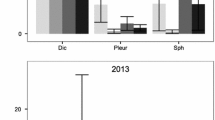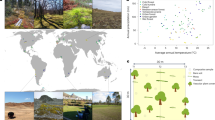Abstract
Mosses dominate many northern ecosystems and their presence is integral to soil thermal and hydrological regimes which, in turn, dictate important ecological processes. Drivers, such as climate change and increasing herbivore pressure, affect the moss layer thus, assessment of the functional role of mosses in determining soil characteristics is essential. Field manipulations conducted in high arctic Spitsbergen (78° N), creating shallow (3 cm), intermediate (6 cm) and deep (12 cm) moss layers over the soil surface, had an immediate impact on soil temperature in terms of both average temperatures and amplitude of fluctuations. In soil under deep moss, temperature was substantially lower and organic layer thaw occurred 4 weeks later than in other treatment plots; the growing season for vascular plants was thereby reduced by 40%. Soil moisture was also reduced under deep moss, reflecting the influence of local heterogeneity in moss depth, over and above the landscape-scale topographic control of soil moisture. Data from field and laboratory experiments show that moss-mediated effects on the soil environment influenced microbial biomass and activity, resulting in warmer and wetter soil under thinner moss layers containing more plant-available nitrogen. In arctic ecosystems, which are limited by soil temperature, growing season length and nutrient availability, spatial and temporal variation in the depth of the moss layer has significant repercussions for ecosystem function. Evidence from our mesic tundra site shows that any disturbance causing reduction in the depth of the moss layer will alleviate temperature and moisture constraints and therefore profoundly influence a wide range of ecosystem processes, including nutrient cycling and energy transfer.






Similar content being viewed by others
References
Bardgett RD, Streeter TC, Cole L, Hartley IR (2002) Linkages between soil biota, nitrogen availability, and plant nitrogen uptake in a mountain ecosystem in the Scottish Highlands. Appl Soil Ecol 19:121–134
Beringer J, Lynch AH, Chapin FS, Mack M, Bonan GB (2001) The representation of arctic soils in the land surface model: the importance of mosses. J Clim 14:3324–3335
Brooker RW, Van der Wal R (2003) Can soil temperature direct the composition of high arctic plant communities? J Veg Sci 14:535–542
Brookes PC, Landman A, Pruden G, Jenkinson DS (1985) Chloroform fumigation and the release of soil-nitrogen—a rapid direct extraction method to measure microbial biomass nitrogen in soil. Soil Biol Biochem 17:837–842
Dyrness CT (1982) Control of depth to permafrost and soil temperature by the forest floor in black spruce/feathermoss communities. United States Forest Service Research Note PNW-396
Fisk MC, Schmidt SK, Seastedt TR (1998) Topographic patterns of above- and belowground production and nitrogen cycling in Alpine tundra. Ecology 79:2253–2266
Giblin AE, Nadelhoffer KJ, Shaver GR, Laundre JA, Mckerrow AJ (1991) Biogeochemical diversity along a riverside toposequence in Arctic Alaska. Ecol Monogr 61:415–435
Gornall JL (2005) The functional role of mosses in arctic ecosystems. Ph. D thesis, University of Aberdeen, Aberdeen
Hartley AE, Neill C, Melillo JM, Crabtree R, Bowles FP (1999) Plant performance and soil nitrogen mineralization in response to simulated climate change in subarctic dwarf shrub heath. Oikos 86:331–343
Hinzman LD, Kane DL, Gieck RE, Everett KR (1991) Hydrologic and thermal-properties of the active layer in the Alaskan Arctic. Cold Reg Sci Tech 19:95–110
Hobbie SE (1996) Temperature and plant species control over litter decomposition in Alaskan tundra. Ecol Monogr 66:503–522
Hobbie SE, Schimel JP, Trumbore SE, Randerson JR (2000) Controls over carbon storage and turnover in high-latitude soils. Glob Change Biol 6:196–210
Jaeger CH, Monson RK, Fisk MC, Schmidt SK (1999) Seasonal partitioning of nitrogen by plants and soil microorganisms in an Alpine ecosystem. Ecology 80:1883–1891
Jónsdóttir IS, Magnússon B, Gudmundsson J, Elmarsdóttir Á, Hjartarson H (2005) Variable sensitivity of plant communities in Iceland to experimental warming. Glob Change Biol 11:553–563
Littell RC, Milliken GA, Stroup WW, Wolfinger RD (1996) SAS system for mixed models. SAS Institute, Cary
Longton RE (1992) The role of bryophytes and lichens in terrestrial systems. In: Bates JW, Farmer AM (eds) Bryophytes and lichens in a changing environment. Oxford University Press, New York, pp 32–76
Longton RE (1997) The role of bryophytes and lichens in polar ecosystems. In: Woodin SJ, Marquiss M (eds) Ecology of Arctic environments. Blackwell, Oxford, pp 69–96
Luthin JN, Guymon GL (1974) Soil moisture–vegetation–temperature relationships in central Alaska. J Hydrol 23:233–246
Matthews JA, Dahl SO, Berrisford MS, Nesje A (1997) Cyclic development and thermokarstic degradation of palsas in the mid-Alpine zone at Leirpullan, Dovrefjell, southern Norway. Permafrost Periglac 8:107–122
Miller PC (1982) Environmental and vegetational variation across a snow accumulation area in Montane tundra in central Alaska. Holarctic Ecol 5:5–98
Miller PC, Webber PJ, Oechel WC, Tieszen LL (1980) Biophysical processes and primary production. In: Brown J, Miller PC, Tieszen LL, Bunnell FL (eds) An Arctic ecosystem: the coastal tundra at Barrow, Alaska. Dowden, Hutchinson and Ross Inc., Stroudsburg, pp 66–101
Molau U, Alatalo JM (1998) Responses of subarctic-Alpine plant communities to simulated environmental change: biodiversity of bryophytes, lichens, and vascular plants. Ambio 27:322–329
Nadelhoffer KJ, Giblin AE, Shaver GR, Laundre JA (1991) Effects of temperature and substrate quality on element mineralization in 6 Arctic soils. Ecology 72:242–253
Oechel WC, Van Cleve K (1986) The role of bryophytes in nutrient cycling in the Taiga. In: Van Cleve K, Chapin III FS, Flanagan PW, Viereck LA, Dyrness CT (eds) Forest ecosystems in the Alaskan Taiga: a synthesis of structure and function. Springer, New York, pp 121–137
Olofsson J, Kitti H, Rautiainen P, Stark S, Oksanen L (2001) Effects of summer grazing by reindeer on composition of vegetation, productivity and nitrogen cycling. Ecography 24:13–24
Olofsson J, Stark S, Oksanen L (2004) Reindeer influence on ecosystem processes in the tundra. Oikos 105:386–396
Press MC, Potter JA, Burke MJW, Callaghan TV, Lee JA (1998) Responses of a subarctic dwarf shrub heath community to simulated environmental change. J Ecol 86:315–327
Robinson CH, Wookey PA, Parsons AN, Potter JA, Callaghan TV, Lee JA, Press MC, Welker JM (1995) Responses of plant litter decomposition and nitrogen mineralization to simulated environmental change in a high arctic polar semi-desert and a subarctic dwarf shrub heath. Oikos 74:503–512
Robinson CH, Wookey PA, Lee JA, Callaghan TV, Press MC (1998) Plant community responses to simulated environmental change at a high arctic polar semi-desert. Ecology 79:856–866
Ross DJ (1990) Influence of soil mineral-nitrogen content on soil respiratory activity and measurements of microbial carbon and nitrogen by fumigation–incubation procedures. Aust J Soil Res 28:311–321
Ross DJ (1992) Influence of sieve mesh size on estimates of microbial carbon and nitrogen by fumigation extraction procedures in soils under pasture. Soil Biol Biochem 24:343–350
Rønning OI (1996) The flora of Svalbard, 3rd edn. Norwegian Polar Institute, Oslo
Sharratt BS (1997) Thermal conductivity and water retention of a black spruce forest floor. Soil Sci 162:576–582
Shaver GR, Nadelhoffer KJ, Giblin AE (1990) Biogeochemical diversity and element transport in a heterogeneous landscape, the North Slope of Alaska. In: Turner M, Gardner R (eds) Quantitative methods in landscape ecology. Springer, New York, pp 105–125
Shulgin AM (1957) The temperature regime of soils. Israel Program for Scientific Translations, Jerusalem
Skre O, Oechel WC (1979) Moss production in a black spruce (Picea mariana) dominated forest with permafrost near Fairbanks, Alaska. In: Sonesson M, Kallio P (eds) Proceedings of the first Fennoscandian tree-line conference, Kevo, Finland, 6–14 September, 1977
Skre O, Oechel WC (1981) Moss functioning in different Taiga ecosystems in interior Alaska. 1. Seasonal, phenotypic, and drought effects on photosynthesis and response patterns. Oecologia 48:50–59
Sonesson M, Bergman H (1980) Area-harvesting as a method of estimating phytomass changes in a tundra mire. In: Sonesson M (ed) Ecology of a subarctic mire, vol 30. Swedish Natural Science Research Council, Stockholm, pp 127–137
Sparling GP, Feltham CW, Reynolds J, West AW, Singleton P (1990) Estimation of soil microbial C by a fumigation extraction method—use on soils of high organic-matter content, and a reassessment of the Kec-factor. Soil Biol Biochem 22:301–307
Van Cleve K, Yarie J (1986) Interaction of temperature, moisture and soil chemistry in controlling nutrient cycling and ecosystem development in the taiga of Alaska. In: Van Cleve K, Chapin III FS, Flanagan PW, Viereck LA, Dyrness CT (eds) Forest ecosystems in the Alaskan Taiga. A synthesis of structure and function. Springer, New York, pp 160–189
Van der Wal R (2006) Do herbivores cause habitat degradation or vegetation state transition? Evidence from the tundra. Oikos 114:177–186
Van der Wal R, Brooker RW (2004) Mosses mediate grazer impacts on grass abundance in arctic ecosystems. Funct Ecol 18:77–86
Van der Wal R, Bardgett RD, Harrison KA, Stien A (2004) Vertebrate herbivores and ecosystem control: cascading effects of faeces on tundra ecosystems. Ecography 27:242–252
Vance ED, Brookes PC, Jenkinson DS (1987) An extraction method for measuring soil microbial biomass-C. Soil Biol Biochem 19:703–707
Viereck LA, Van Cleve K, Dyrness CT (1986) Forest ecosystem distribution in the taiga environment. In: Van Cleve K, Chapin III FS, Flanagan PW, Viereck LA, Dyrness CT (eds) Forest ecosystems in the Alaskan Taiga. A synthesis of structure and function. Springer, New York, pp. 22–43
Walker DA, Halfpenny JC, Walker MD, Wessman CA (1993) Long-term studies of snow–vegetation interactions. Bioscience 43:287–301
Walker MD, Wahren CH, Hollister RD, Henry GHR, Ahlquist LE, Alatalo JM, Bret-Harte MS, Calef MP, Callaghan TV, Carroll AB, Epstein HE, Jónsdóttir IS, Klein JA, Magnússon B, Molau U, Oberbauer SF, Rewa SP, Robinson CH, Shaver GR, Suding KN, Thompson CC, Tolvanen A, Totland Ø, Turner PL, Tweedie CE, Webber PJ, Wookey PA (2006) Plant community responses to experimental warming across the tundra biome. PNAS 103:1342–1346
Webber PJ (1978) Spatial and temporal variation of the vegetation and its productivity. In: Tieszen LL (ed) Vegetation and production ecology of an Alaskan arctic tundra. Springer, New York, pp 37–112
Weih M (1998) Seasonality of nutrient availability in soils of subarctic mountain birch woodlands, Swedish lapland. Arct Alp Res 30:19–25
Whalley WR (1993) Considerations on the use of time-domain reflectometry (TDR) for measuring soil–water content. J Soil Sci 44:1–9
Zimov SA, Chuprynin VI, Oreshko AP, Chapin FS, Reynolds JF, Chapin MC (1995) Steppe-tundra transition—a herbivore-driven biome shift at the end of the Pleistocene. Am Nat 146:765–794
Acknowledgments
We are grateful to Hera Sengers and Anne-Mette Pedersen for invaluable help with field and laboratory work and Chris Mullins for providing essential equipment. We also thank Richard Bardgett for allowing laboratory work to be undertaken within the Ecology Research group at Lancaster University. This work was funded by NERC (NER/S/A/2001/05958).
Author information
Authors and Affiliations
Corresponding author
Additional information
Communicated by Allan Green and Sven Jonasson.
Rights and permissions
About this article
Cite this article
Gornall, J.L., Jónsdóttir, I.S., Woodin, S.J. et al. Arctic mosses govern below-ground environment and ecosystem processes. Oecologia 153, 931–941 (2007). https://doi.org/10.1007/s00442-007-0785-0
Received:
Accepted:
Published:
Issue Date:
DOI: https://doi.org/10.1007/s00442-007-0785-0




